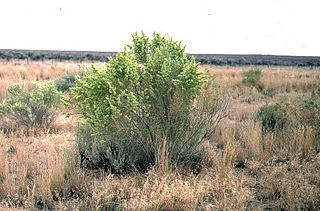
Quinoa is an annual seed-producing flowering plant grown as a grain crop. It is a pseudocereal, not a grass, unlike wheat and rice. It is botanically related to spinach.
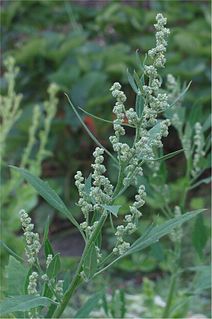
Chenopodium album is a fast-growing weedy annual plant in the genus Chenopodium.

Blitum bonus-henricus, also called Good-King-Henry, Poor-man's Asparagus, Perennial Goosefoot, Lincolnshire Spinach, Markery, English mercury, or mercury goosefoot, is a species of goosefoot which is native to much of central and southern Europe.

Dysphania ambrosioides, formerly Chenopodium ambrosioides, known as wormseed, Jesuit's tea, Mexican-tea, payqu(paico), epazote, mastruz, or herba sanctæ Mariæ, is an annual or short-lived perennial herb native to Central America, South America, and southern Mexico.

Chenopodium is a genus of numerous species of perennial or annual herbaceous flowering plants known as the goosefoots, which occur almost anywhere in the world. It is placed in the family Amaranthaceae in the APG II system; older classification systems, notably the widely used Cronquist system, separate it and its relatives as Chenopodiaceae, but this leaves the rest of the Amaranthaceae polyphyletic. However, among the Amaranthaceae, the genus Chenopodium is the namesake member of the subfamily Chenopodioideae.

Chenopodium pallidicaule, known as cañihua, canihua or cañahua and also kaniwa, is a species of goosefoot, similar in character and uses to the closely related quinoa(Chenopodium quinoa).

Strawberry blite is an edible annual plant, also known as blite goosefoot, strawberry goosefoot, strawberry spinach, Indian paint, and Indian ink.

Chenopodium berlandieri, also known by the common names pitseed goosefoot, huauzontle, lamb's quarters, and lambsquarters is an annual herbaceous plant in the goosefoot family.
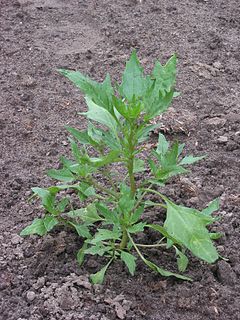
Oxybasis rubra(syn. Chenopodium rubrum), common names red goosefoot or coastblite goosefoot, is a member of the genus Oxybasis, a segregate of Chenopodium. It is native to North America and Eurasia. It is an annual plant.
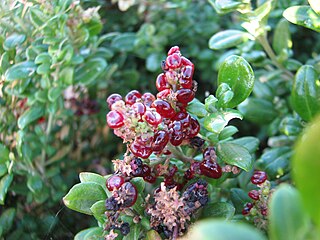
Chenopodium candolleanum, commonly known as Seaberry Saltbush, is a shrub in the subfamily Chenopodioideae of the family Amaranthaceae, native to Australia.
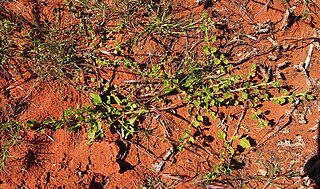
Dysphania melanocarpa, commonly known as Black Crumbweed, is an annual herb that grows in arid and semi-arid regions of Australia.

Chenopodium fremontii is a species of flowering plant in the amaranth family known by the common name Frémont's goosefoot. Both the species' specific epithet, and the common name derive from the 19th century western pioneer John C. Frémont.
Chenopodium littoreum is an uncommon species of flowering plant in the amaranth family. It is endemic to California, known only from sections of the coastline of central California, in San Luis Obispo and Santa Barbara Counties.
Coleophora squalorella is a moth of the family Coleophoridae. It is found from Fennoscandia to Austria, Croatia, Romania and Ukraine and from the Netherlands to the Baltic states. It is also known from the lower Volga and Ural regions of Russia and China. It occurs in steppe and semi-desert biotopes.

Dysphania is a plant genus in the family Amaranthaceae, distributed worldwide from the tropics and subtropics to warm-temperate regions.

Oxybasis glauca, common name oak-leaved goosefoot, is a species of goosefoot plant native to Europe. It has been introduced and become an invasive weed in North America. This invader of European origin also appears in trampled communities in North Korea.

Chenopodium parabolicum, commonly known as fragrant saltbush or mealy saltbush, is a shrub in the family Amaranthaceae. The species is native to Australia.

Dysphania pusilla, formerly Chenopodium pusillum, otherwise known as pygmy goosefoot or parahia in Māori, is a prostrate herb endemic to the north-eastern parts of South Island, New Zealand. Presumed extinct after 56 years without recorded observations, the species was rediscovered in 2015.

Chenopodium desertorum, common name frosted goosefruit, is a species of flowering plant in the amaranth family, indigenous to Australia where it is found in all mainland states.






